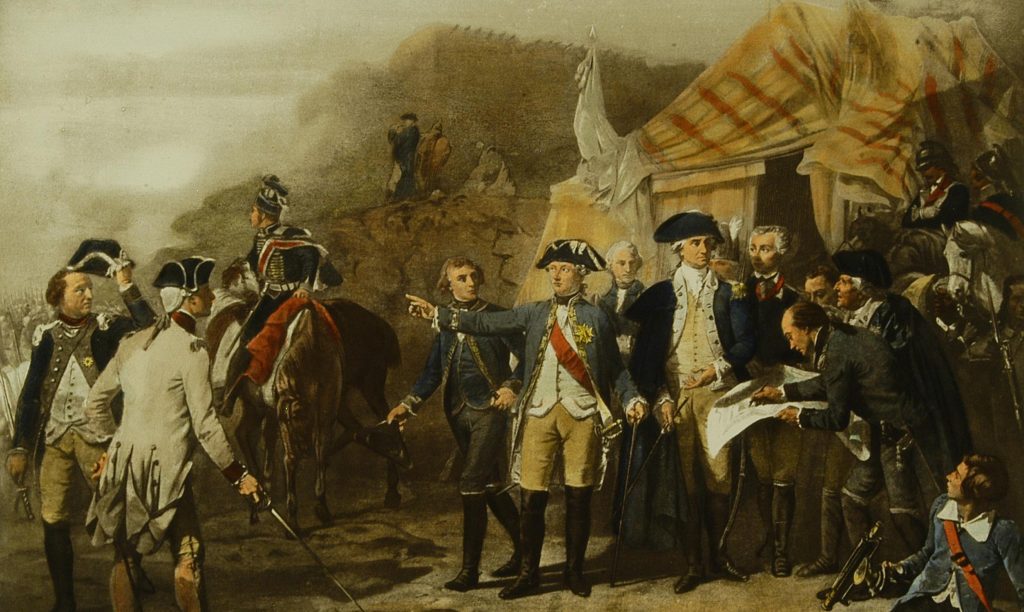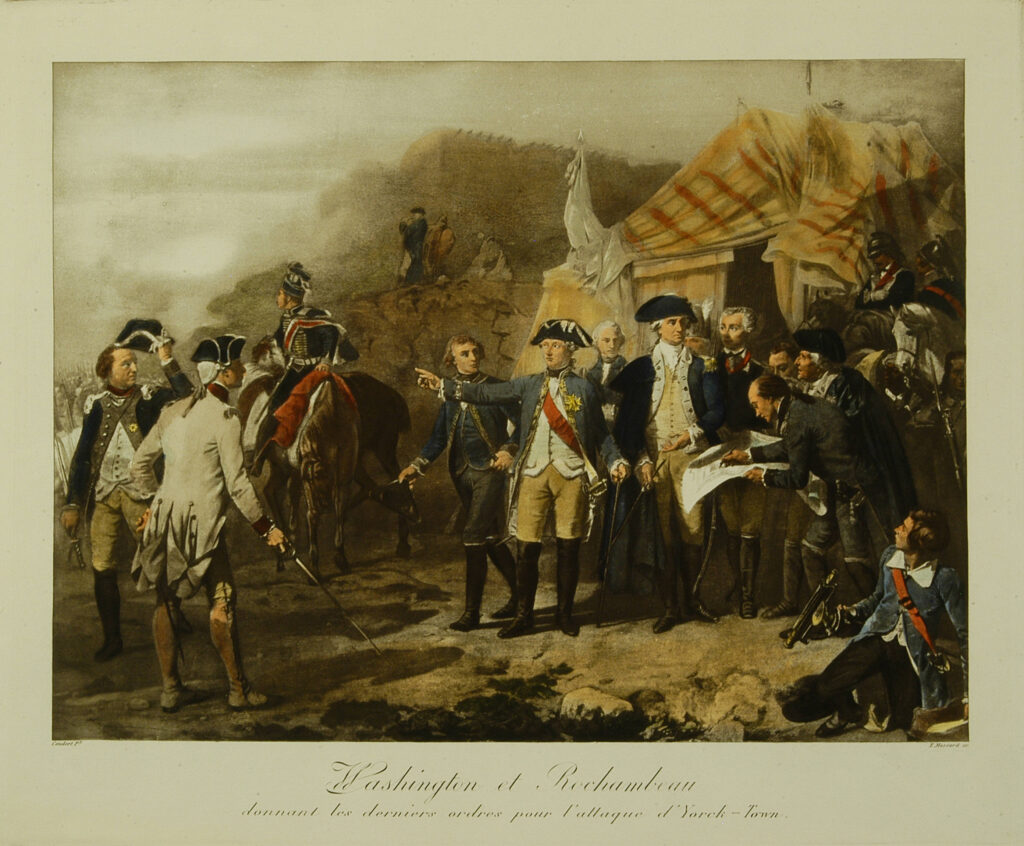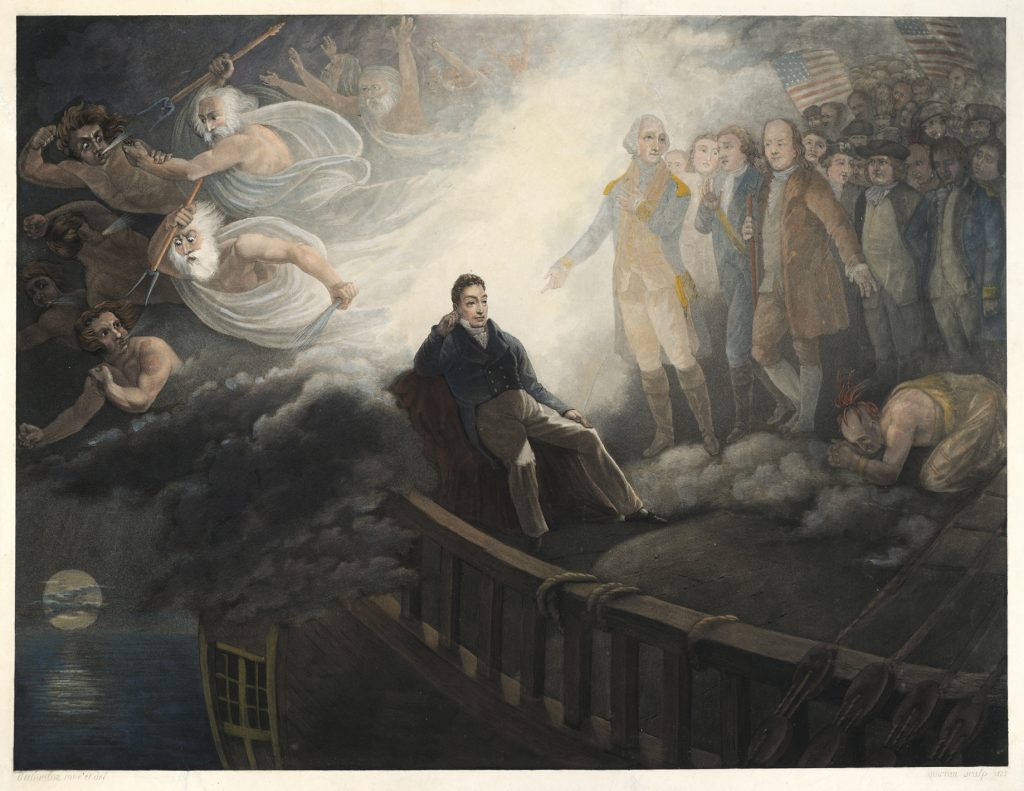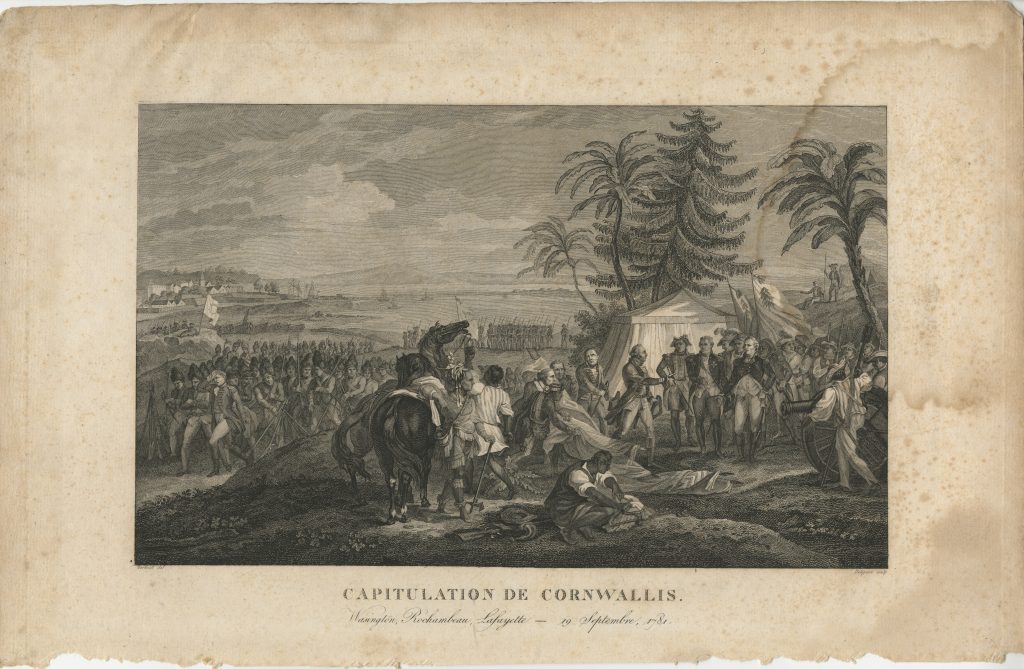Anne Hester, East Lee County High School, Lehigh Acres, Florida
DESIGN LEVEL: High School

Overview
The relationship between France and the United States as political and military allies is one that began with the American Revolution and has continued to the present day. The best representation of this relationship is not one of philosophy or the shared influence of the Enlightenment; it is the personal relationship between George Washington and Marie-Joseph Paul Yves Roch Gilbert du Motier, the Marquis de Lafayette.
The interaction and the friendship between these two men during the American Revolution and beyond is a microcosm of the relationship between the two nations. By looking at the association of Washington and Lafayette as well as how the association started and evolved, one can see that it is a study of how the United States and France connected and evolved as two countries breaking free of former allegiances and customs to form new, independent and allied nations.
Objectives
Students will:
- Discuss and evaluate the effect of specified events and people on the decision to declare America independent of Britain.
- Discuss the progression of the American Revolution before and after France’s alliance.
- Evaluate the effect of the Franco-American alliance in the American Revolution and the Washington-Lafayette relationship on the French Revolution.
- Discuss the relationship between Lafayette and Washington and argue whether it was a friendship, a mentorship or something deeper (i.e. familial) while providing evidence for the argument.
- Judge the effect of the 1793 Neutrality Proclamation on the Washington/Lafayette and France/United States relationships and provide support for the argument.
Materials
Prior to beginning this lesson, the students should have read and have an understanding of the American Declaration of Independence, the Neutrality Proclamation of 1793 and the United States Constitution. These documents can be found at http://teachingamericanhistory.org.
Day 1:
- History.com. “George Washington.” History.com, A&E Television Networks, 2009, www.history.com/topics/us-presidents/george-washington.
- Klein, Christopher. “10 Things You May Not Know About the Marquis De Lafayette.”History.com, A&E Television Networks, 20 Oct. 2015, www.history.com/news/10-things-you-may-not-know-about-the-marquis-de-lafayette.
- Stockwell, Mary. “Marquis De Lafayette.” George Washington’s Mount Vernon, www.mountvernon.org/digital-encyclopedia/article/marquis-de-lafayette/.
Day 2:
- Ms. Hester’s sample grading rubric.
- Washington meets Lafayette for the first time (Turn): https://www.youtube.com/watch?v=1xSQNShfbPQ.
- The British Surrender at Yorktown (Turn): https://www.youtube.com/watch?v=iaFRnSmat3o.
- “Washington et Rochambeau Donnant Les Derniers Ordres Pour L’attaque d’ Yorck- Town.” The Society of the Cincinnati, (see gallery below).
- “Capitulation de Cornwallis: Wasington [sic], Rochambeau, Lafayette, 19 Septembre, 1781.” The Society of the Cincinnati, (see gallery below).
- “Le Général Lafayette.” The Society of the Cincinnati, (see gallery below).
Day 3:
- Gaines, James R. “Washington and Lafayette.” Smithsonian Magazine, Sept. 2007, http://www.smithsonianmag.com/history/washington-amp-lafayette-162245867/.
- Dehler, Gregory J. “Neutrality Proclamation.” George Washington’s Mount Vernon, https://www.mountvernon.org/library/digitalhistory/digital-encyclopedia/article/neutrality-proclamation/.
- Miller, Lynn H. “My Dear General: the Relationship between Lafayette and Washington.” France Revisited, 9 Apr. 2016, https://francerevisited.com/2009/08/my-dear-general-the-relationship-between-lafayette-and-washington/.
- “The Citizen Genêt Affair, 1793–1794.” U.S. Department of State, https://history.state.gov/milestones/1784-1800/citizen-genet#:~:text=The%20Gen%C3%AAt%20affair%20forced%20the,bill%20on%20June%204%2C%201794.
- Declaration of the Rights of Man, http://avalon.law.yale.edu/18th_century/rightsof.asp.
Recommended Time
Four class periods: three class periods (84 minutes per class period in block scheduling) for instruction and cooperative learning, one class period for assessment.
DAY 1:
Anticipatory Set/Bell Ringer (10 minutes)
Students will answer the bell ringer questions, “What do you know about the American Revolution?” and “What people related to the Revolution do you know about?” so that teacher can estimate background knowledge and start a dialogue with students.
Introduction of New Material (30 minutes)
Lecture Notes:
Causes of the American Revolution
- The French and Indian War (1754-1763) was a dispute between the French (and their American Indian allies) and the British (and their American Indian allies) over control of certain parts and resources of North America.
- Because of the war’s end, American colonists are taxed to pay the large bill for defense of the colonies. These taxes did not include representation and redress to Parliament. Colonial disagreement and dissatisfaction with this policy spreads.
- When the colonists push Great Britain for representation and alleviation of tax burdens, Great Britain pushes back with the Intolerable/Coercive Acts. Rather than suppressing rebellion, this increases it. The Boston Massacre and the Boston Tea Party are examples of colonial dissatisfaction as it turns into rebellion.
The colonies needed European allies to help supply money, arms, uniforms, food and military strength. The possible European allies included:
- France
- Spain
- The Netherlands/Holland
- Other nations
Certain important figures of the American Revolution will be introduced and discussed. These will include, but are not limited to:
- George Washington
- John Adams
- Samuel Adams
- Thomas Jefferson
- Baron von Steuben
- Marquis de Lafayette
- King George III
- King Louis XVI
- Benjamin Franklin
Further Exploration (40 minutes)
To focus the lesson and to further introduce Washington and Lafayette, the students and teacher will view the history.com, Stockwell and Klein website articles listed under “Resources.” (20 minutes)
Students will break into groups designated by the instructor. Each group will work together to research one of the individuals on the list from part three of the introduction of new material and create an introduction of their person for the rest of the class. Students will, in their verbal presentation, be able to answer the following questions:
- Who is your person (full name) and where is he from?
- What role did he play in the American Revolution?
- What is your person most remembered for?
- What is one thing you found interesting about your person?
Research will take the remaining 20-24 minutes of class, and presentations should be no more than three minutes in length per group. The “introductions” will start day two of the lesson.
Exit Ticket (last 5 minutes)
Students will answer the question, “What do you want to be remembered for?”
DAY 2:
Anticipatory Set/Bell Ringer (5 minutes)
Students will answer the bell ringer questions, “Tell me one thing about your person that isn’t in your presentation” and “What person do you want to know more about” so that teacher can kick start learning from the previous class.
Student Presentations (20-25 minutes)
Student presentations—see Ms. Hester’s sample grading rubric.
Introduction of New Material (30 minutes)
After presentations, teacher will redirect the class and focus the information on French involvement in the American Revolution, the end of the war and America’s influence on the French Revolution.
Lecture Notes:
Course of the American Revolution
- The Revolution was not going well for the United States, and it needed support from a more powerful nation. It took a victory at Saratoga for France to pledge its support.
- One of the conditions of French involvement was that the United States would militarily support France if needed. The man who is credited with bringing the French into the war (and acting as an ambassador) was the Marquis de Lafayette.
- Once France became America’s ally, it caused the British to fight in several areas at once (northern colonies, southern colonies, the Caribbean). The result was that the war cost Great Britain too many lives and too much money. The British surrendered at Yorktown, Virginia in 1781.
Consequences of the American Revolution
- The end of the Revolutionary War brought independence for thirteen American states. Between 1776 and 1780, the states wrote new constitutions or changed their old charters to become republics. The Treaty of Paris of 1783 officially ended the war.
- When the alliance of the states under the Articles of Confederation proved inadequate, a convention in 1787 produced the Constitution, which remains our governmental framework. The Constitution settled many issues and formed a stronger union of the states.
- The American victory against Great Britain inspired the French people to rebel against their monarchist government and the noble classes. The Marquis de Lafayette (and many others) were arrested, tried and executed.
The French Revolution
- Over 10,000 people were executed during the French Revolution (1789-1799). After French King Louis XVI and Queen Marie Antoinette were tried and executed in 1793, war between France and monarchal nations Great Britain and Spain was inevitable. These two powers joined Austria and other European nations in the war against Revolutionary France that had already started in 1791.
- France asked the United States for assistance against the other European nations, but America’s response was the Neutrality Proclamation of 1793. The argument was that the agreement of support, given during the American Revolution, was made with the King of France (who was dead).
- The United States did not get involved in the French Revolution or the defense of the nation. Many Americans were upset by this because they felt we were betraying our allies.
- The French Revolution finally concluded, and France began to rebuild.
Further Exploration (20 minutes)
- Students will re-organize into different groups than they were in for their person presentations.
- Each group will be assigned one of the images from today’s “Resources.” One person in the group will be designated the recorder, while the others conduct research and analyze the image. One person will be designated the “responder” for the questions asked during the next class session.
- Today, students will discuss basic elements of their images, research the context of the images and be able to answer the following questions:
a) What is the image’s title? (please give the students this information as a kickstart to research)
b) Who is the artist and what country is the image/artist from?
c) In what year was the image created?
d) Who/what is pictured in the image?
e) What is the context of the image?
f) If your image is an event, what is the significance of the event? If your image is a person, what is important about the person?
g) These figures’ positive qualities (as portrayed in the paintings) were also the positive qualities the artists wished to attribute to the country of the subject. What positive qualities is the artist trying to portray? How can you tell?
h) How does the choice of subject in the image fit into what we have been studying? (Why is it important?)
Exit Ticket (last 5 minutes)
Students will be able to answer the question, “If you were George Washington, would you have declared neutrality or would you have brought the United States into France’s revolution? Why or why not?”
DAY 3:
Anticipatory Set/Bell Ringer (10 minutes)
Students will answer the bell ringer question, “What are three similarities and three differences between the American and the French Revolutions?” so that teacher can kick start learning from the previous class.
Student Presentations (10-15 minutes)
Student groups will meet briefly to discuss any last-minute business and return to seats. Instructor will ask the responders from each group one or two of the questions that the groups had to answer during the last class session as a way of reviewing material from the previous classes and as a springboard to today’s lesson.
Introduction of New Material (30 minutes)
After bell ringers, teacher will redirect the class and focus the information on the aftermath of the French Revolution for France and the United States.
Lecture Notes:
Effects of the French Revolution on the United States
- Due to Lafayette’s social status, military history and political position, he was arrested by the Austrians (the family of Marie Antoinette) who held Lafayette personally responsible for the French Revolution and the death of the French royal family. He was held prisoner until 1797 when Napoleon invaded Austria and made Lafayette’s release one of the conditions for a peace treaty.
- Thomas Paine, American author of Common Sense, went to France to assist with the revolution. His anti-death penalty philosophy caused him to speak out against the Reign of Terror and he was arrested in 1793. Eventually he was released (due to the political influence of President James Monroe) but stayed in France because of his negative reputation in America. He did return to America but died a few years later, penniless and despised.
- The United States’ reputation as a world power was secured, and American ambassadors used this reputation to secure the release of Lafayette’s family. They were unable to secure Lafayette’s release. The violence and bloodshed of the French Revolution turned American sentiment for their allies into feelings of disgust and separation.
Could the United States be diplomatic but militarily neutral?
- Due to the Neutrality Proclamation of 1793, the United States stayed out of France’s politics.
- Some French people, particularly a man called “Citizen Genet” came to the United States and attempted to gain American sympathy and military support for France.
- Against the instructions of the American government, Genet enlisted ships and men to defend France and protect her interests in the Caribbean. Since this went against neutrality, the United States demanded Genet’s recall to France. Once it was discovered that Genet would probably be executed if he returned to France, he was allowed to stay in the United States but had to stop his recruiting activities.
- By stopping Genet and not giving official support, the United States was able to maintain neutrality and a working relationship with other nations. (France, Great Britain, Spain, etc.)
Washington is America and Lafayette is France?
- The American Constitution (based on several British ideas) and the Declaration of Independence became the basis for the French Declaration of the Rights of Man.
- The men, who never saw each other again after 1784, remained friends until Washington’s death in 1799. They wrote to each other frequently and Lafayette even had a room at Washington’s home, Mount Vernon. Lafayette named his eldest son after Washington.
- Lafayette returned to the United States in 1824 for a final visit, stopping at Mount Vernon to visit Washington’s tomb on the property.
- France is considered one of the United States’ oldest “friends,” fighting side by side in both world wars.
Further Exploration (20 minutes)
Students will work in pairs chosen as the instructor deems appropriate. Each pair will read and discuss one of the articles found in this class session’s “Resources” section.
After reading the article, each team will discuss it and be able to answer the following questions:
- What was it about these men that helped them bond so personally?
- Based on your readings, the class discussions and your own opinion, why have Washington and Lafayette become symbols of their respective nations? Use the source material from the last three class periods to support your answer.
- Students will submit their answers after the assessment during the next class session.
Exit Ticket (last 10 minutes of class):
Students will be able to answer the following question: “After the French Revolution and his release from prison, Lafayette indirectly gave Washington the key to the Bastille. What was the meaning of this gift? Was it personal or national? Why do you think that, based on what we have discussed in this lesson?”
DAY 4:
Asessment:
In a format designated by the instructor, students will be able to answer the following questions and use textual/image support for their responses. A point value of 10 points per question is suggested.
- Is the relationship between Washington and Lafayette a relationship between individuals, ambassadors of their countries or a combination of the two?
- Specify and defend: What kind of relationship did Washington and Lafayette have? Was it friendly, familial, mentoring or something else? Justify your answer with support from the discussion.
- How does the relationship between Washington and Lafayette compare to the relationship between the United States and France during and after the American Revolution?
- To what extent was America (and her representatives) pivotal in helping to create a “New France?” How did the Citizen Genet support or jeopardize that relationship?
- Create a gift (a drawing or other rendering) that you think would be appropriate today for the United States to give to an allied nation. Include why you feel your gift is appropriate.
Students will submit their assessments and their responses to the two questions from the previous class sessions.

Washington et Rochambeau donnant les derniers ordres pour l'attaque d' Yorck-Town
Louis-Charles-Auguste Couder, artist, Felix Massard, engraver
Paris? ca. 1840The Society of the Cincinnati
Engraving of Rochambeau, Washington and Lafayette standing outside a tent on the battlefield at Yorktown with their officers, reviewing the plans for the battle.
Le General Lafayette
Achile Moreau, engraver, after Jean August Dubouloz, artist
1825The Society of the Cincinnati, The Robert Charles Lawrence Fergusson Collection
Lafayette is sitting on the deck of the Brandywine with dark clouds above breaking so a shaft of light falls on him. In the clouds to the right are figures of the American Revolution, headed by George Washington.